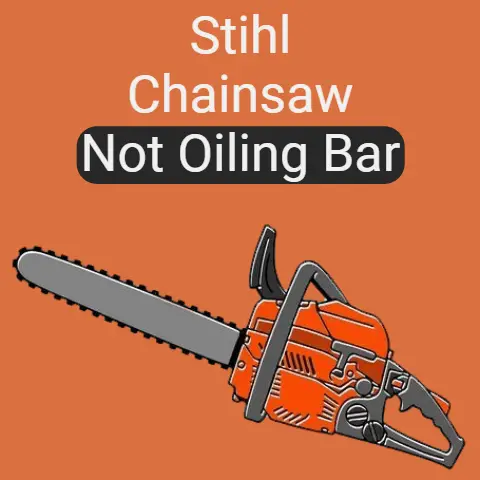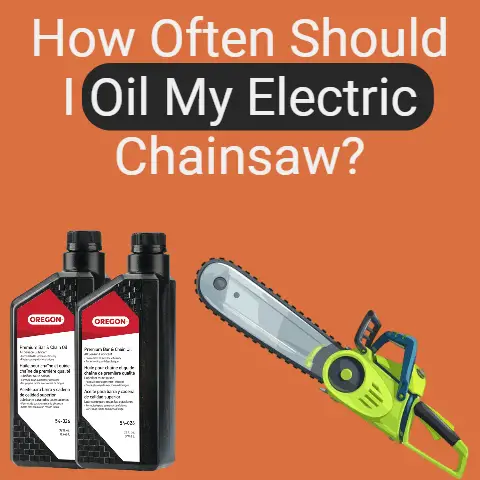Ryobi Chainsaw Leaking Oil (13 Ways To Fix Explained)
The easiest way to stop oil leaking is to store chainsaw’s “blade up/upright.” You can also drain the oil out after use and set it on pig mats/plastic bins/cardboard. Every chainsaw I’ve owned has leaked. Unless it’s leaking a significant amount, don’t worry about it.
Have you ever been using your chainsaw, and suddenly to your astonishment, you see a thick black liquid start to ooze from the back of your Ryobi chainsaw onto the ground?
If you have, then you have experienced an oil leak.
This post will answer the questions on, how to find out where it is coming from and how to stop it permanently.
Ryobi Electric Chainsaw Oil Leak – First Verification Steps
If you’re dealing with a Ryobi electric chainsaw oil leak, don’t worry – you’re not alone.
This is a common issue that can be caused by a variety of factors, such as a loose oil cap or a damaged oil tank.
Types of Oil Leakage
There are mainly two reasons for oil leaks. They are:-
- Usual oil leakage, due to oil pressure inside the oil tanks.
- Unusual oil leakage due to damage in oil tanks, pipes, or tubes.
No matter what caused the chainsaw oil leakage, you have to handle it immediately to avoid any inconvenience or mishap.
Otherwise, the entire oil reserved will be drained, and you’ll have to pay more to buy it.
#1
Fixing Usual oil leakage
Every Ryobi chainsaw I’ve owned has leaked.
Unless it’s leaking a significant amount, don’t worry about it.
It is normal, but you can do the below things to stop oil leakage:-
- Put the right amount of oil that will be finished at the end of your cutting.
- Drain the oil reservoir out, after use.
- If you cannot drain the oil, keep it on something easy to drain/clean after whatever is left leaks out.
You can use pig mats/plastic bins/cardboard. - Store the Ryobi chainsaw “blade up/upright.”
- Use biodegradable oil.
- Use a new brushless chainsaw. This will stop the oil leakage.
Fixing Unusual Oil Leakage
There are a few common reasons why a Ryobi chainsaw might leak oil.
#2
Overfilling the oil reservoir
If the chainsaw oil reservoir is too full, the excess oil can leak out through the seals and gaskets.
Check the oil reservoir level.
Make sure that the reservoir is not overfilled.
#3
Damaged or worn seals and gaskets
Over time, the seals and gaskets in a chainsaw can become damaged or worn, which can lead to oil leaks.
Inspect the seals and gaskets for any signs of damage or wear.
If you find any damaged seals or gaskets, replace them.
#4
Cracked or damaged oil reservoir
If the oil reservoir is cracked or damaged, oil can leak out.
Check the oil reservoir for any cracks or damage.
If the reservoir is cracked or damaged, replace it.
#5
Problems with the oil pump
The oil pump is responsible for pumping oil from the reservoir to the chain bar.
If the oil pump is not working properly, it can cause oil leaks.
If you have checked all of the above and the chainsaw is still leaking oil, it is possible that there is a problem with the oil pump.
In this case, you should take the chainsaw to a qualified service technician for repair.
#6
Oil Cap and Reservoir
Make sure that the chainsaw oil cap is securely tightened.
If the cap is loose, it can cause oil to leak.
This issue is commonly reported by Ryobi chainsaw users and can be easily resolved by ensuring proper tightening of the oil cap.
As an experienced chainsaw user, I have encountered similar oil leakage issues in the past.
Based on my expertise, I recommend checking the oil cap regularly to ensure it is tightly secured.
It is possible that the cap may become loose over time due to vibrations during operation, so periodic inspections are essential.
In addition to tightening the oil cap, I suggest cleaning the oil reservoir and cap threads to remove any debris or oil buildup that may be interfering with the cap’s tight seal.
This can be done using a clean cloth or brush.
By keeping the cap and reservoir clean, you can ensure a proper seal, reducing the chances of oil leakage.
If you continue to experience oil leakage despite these measures, it may be worth considering replacing the oil cap.
Over time, the cap’s threads can wear out, compromising its ability to seal tightly.
Visiting a local hardware shop can provide you with the necessary guidance and assistance in obtaining a replacement cap.
Taking proactive steps to prevent oil leakage in your Ryobi chainsaw will not only ensure proper functioning but also extend the lifespan of your equipment.
#7
dirty Oil Ports and Bar Groove
Sometimes, debris and sawdust can accumulate in the chainsaw oil ports and bar groove, obstructing the oil flow.
Clean these areas thoroughly.
If you notice oil leaking from your Ryobi chainsaw when not in use, it could be due to debris and sawdust obstructing the oil flow.
To fix this issue, you should clean the chainsaw oil ports and bar groove thoroughly.
This will ensure proper oil flow and prevent any leaks.
When cleaning the oil ports and bar groove, it is helpful to use a small brush or compressed air to remove any accumulated debris.
Make sure to check these areas regularly and clean them as needed to prevent future leaks.
#8
Incorrect Oil Flow Rate
Some chainsaws have an adjustable oiler.
Check your user manual to see if yours does and adjust it if necessary.
Incorrect Oil Flow Rate can cause oil leak.
#9
Clogged Oil Filter
If your chainsaw has an oil filter, inspect it for any clogs.
Clean or replace it if needed.
#10
worn or damaged Bar and Chain
If the bar or chain is worn or damaged, it can affect the oiling system.
Replace them if necessary.
#11
Wrong Type of Oil
Ensure that you are using the recommended type of bar and chain oil for your chainsaw.
Using the wrong type of oil can lead to problems.
#12
Damage in Oil Pipe/tube
It’s good to fix the damage on the spot to save oil and avoid unwanted incidents.
When taking your cordless chainsaw to an expert for repair, there may be a situation that may not be possible to handle.
In remote areas, he may not be easily accessible.
Another possibility is that you may have no internet facility to search online and see video tutorials about fixing the bar chain oil leaks.
Of a truth, it is pertinent for you to be conversant with the best actions to take without frivolities.
It’s time to take action.
Various steps are involved in carrying out the procedure.
These are mentioned below:
Dismantling The Ryobi Chainsaw
Take the Ryobi chainsaw chain and bar off with its tensioning cover.
In the chain driver cog, there’s a flying circlip.
You have to remove it.
Then, move the cog in an upward direction with the short spring and the shield.
It’s possible to remove the main body side cover.
There are three screws on the back motor side cover, where brushes are installed.
Remove those screws too.
Under a clip, behind the trigger, there’s a hidden screw.
Keep in mind, never pull on the armature nut.
If you do so, you’ll pull up the entire assembly.
It’ll need an impact hammer.
The big fiber plastic cog with its bearing comes out with pulling.
It can be left beside the armature.
Find Out The Damage
After the dismantling is done, it’s time to know the nature of the damage that occurred to the chainsaw oil tube.
According to tech data, an additive in the Reflo 68A compressor oil can be a reason for the perished PVC tube.
You can have a perfect seal, plastic, and paint compatibility.
An added benefit is a complete synthetic polyalphaolefin benzene-based ammonia refrigeration compressor liquid.
There is a seal swell agent. It prevents oil leakage.
The seal swell agent can be the reason. Remove the bar and the chain.
Wipe out oil drops to make it completely dry and clean.
Its casting bodies can retain oil.
So, you need to make sure it’s properly wiped.
Get a cardboard sheet and put it under the chainsaw.
Leave it there for it to hibernate or rest on its own for up to an hour; you can even leave it to rest there for a longer period.
If there are a few oil drops, it’s normal.
If it has a heavy oil leak, it’s time for further investigation.
Replace The Tube
When you have finally detected the tube’s damage with an oil leak, it’s time to replace it to stop the leakage.
If you have silicone tubing available, it’s okay.
This will prevent further leaks and won’t cause any trouble while using the cordless chainsaw.
It’s a wise idea to have a spare oil tube for the chainsaw at the time of purchase.
It’ll help avoid any issues in case it leaks during operation.
You won’t require to repair the tube.
There will be a new one instantly available.
You can easily fix it and remove the perished one in a hassle-free way within a jiffy, though it’s dependent on the level of your expertise.
Beginners can take more time.
They may need to take the chainsaw to an expert who can repair it for them.
Don’t Forget The Brushes
Before you begin to assemble, pull out the armature brushes.
Then, you’ll be able to put the armature back in its accurate place.
You can use a coin in the cover while you make it tight.
It’ll let you avoid damaging the housing of the brush.
Finger tight can also work in some cases.
Final Assembly of The Chainsaw
When the armature gets fixed properly from a cover, which is flush-mounted, it’s time to lock out the safety lever.
Now, it’s possible to reinstall the spring assembly.
In the end, you can reinstall the main side cover.
After that, reinstall its drive cog and flying circle.
The fixing process is very brief if you’re experienced.
Beginners may take more time as they have no expertise in the assembling of the chainsaw.
#13
Contact Ryobi Customer Support
If you’ve tried the above steps and the issue persists, it’s a good idea to contact Ryobi’s customer support for further assistance or to inquire about any potential recalls or known issues.
How To Remove Split oil
Bar oil is almost impossible to get off from anything.
It can harm things easily.
You can use Dawn dish soap.
It helps to soften and get the oil off.
You can use Carb/Brake cleaner.
It works great on metallic things but it can strip paint from metal.
You can use biodegradable oil on chainsaws as it is easy to get removed from surfaces.
Final Words
When leaks oil from your Ryobi chainsaw tube, it shows there must be some damage in it.
You can replace the to get rid of this issue.
Immediately inform the manufacturer if you detect any oil leak from the oil pump.
At home, you can follow the above-mentioned steps.





